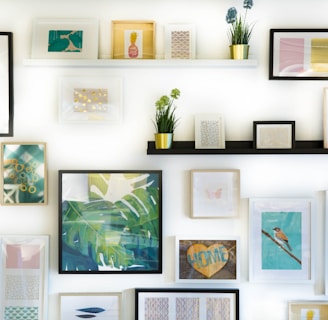Elevate Your Home Design with Cozy Trend Haus Inspiration and Ideas
Discover the beauty of elevated home design at Cozi Trend Haus. Our blog features inspiring interior design ideas, blending high-end aesthetics with cozy charm. Explore styles from modern farmhouse to Japandi and coastal cottage, complete with stunning photography to ignite your creativity and transform your living spaces. -Merita Joy Media
Mary Ann Pinon
5/8/20245 min read
Exploring Home Design Styles: A Guide to Planning Your Perfect Space
By Merita Joy Media
Decorating your home is an exciting journey—one that blends personal expression, creativity, and functionality. Whether you’re moving into a new place or giving your current space a refresh, the design style you choose sets the tone for how your home feels, looks, and flows. From modern minimalism to cozy cottagecore, the options are vast and varied. But before you start buying throw pillows or browsing art prints online, it's essential to take a thoughtful approach.
Here’s a comprehensive guide to understanding the most popular home design styles and how to plan your decor process—from inspiration to execution.
Step 1: Research and Reflect on Your Style
Before diving into furniture catalogs or Pinterest boards, begin by asking yourself what kind of feeling you want your space to evoke. Are you drawn to clean lines and simplicity, or do you love layered textures and vintage pieces? Your personal tastes, lifestyle, and even the architectural bones of your home all play a role in what style will work best.


Popular Styles to Consider:


Modern Farmhouse:
Think warm wood tones, neutral colors, and vintage-inspired charm. Ideal for families and cozy living..
Shop Amazon for these looks:




Japandi:
A hybrid of Japanese minimalism and Scandinavian simplicity. Calm, neutral palettes with natural materials and clutter-free design..
Shop Amazon for these looks:


Industrial:
Urban loft vibes with exposed brick, metal, leather, and repurposed furniture.
Shop Amazon for these looks:




Bohemian:
Eclectic, vibrant, and full of personality. Ideal for creatives and lovers of color, pattern, and vintage finds..
Shop Amazon for this look:


As you explore, start a “style board”—digitally through apps like Pinterest or with a physical collage from magazines. Keep track of recurring themes, color palettes, and furniture shapes you’re drawn to.
Step 2: Define the Function of Each Room
Design should support how you live. A minimalist aesthetic might look great in a magazine, but if you have kids or pets, it needs to be livable too.
Ask yourself:
What activities happen in this room?
How much storage is necessary?
How do I want to feel when I enter this space—calm, energized, grounded?
Understanding the function helps narrow down not just style but materials and layout. For instance, a high-traffic family room may benefit from performance fabrics and durable materials, while a formal sitting room allows for more delicate finishes.


Step 3: Create a Color Palette
Color is one of the most powerful tools in design. Each style has signature colors that guide your palette, but personalization is key. Start with a neutral base that aligns with your chosen style (soft whites for coastal, earth tones for boho, greys for industrial), then layer in accent colors through furniture, textiles, and art.
You can use tools like color wheel apps or paint brand visualizers to experiment before committing. Don’t forget to factor in lighting—natural and artificial light can significantly change how colors appear.


Step 4: Select Furniture That Matches Your Style and Lifestyle
With your style direction and color palette defined, it’s time to look at furniture. Invest in key pieces first—sofas, beds, dining tables—then gradually build out with smaller accents.
When shopping:
Pay attention to materials: Solid woods, linen, metal, or rattan depending on your style.
Look for silhouettes: Mid-century legs vs. overstuffed cushions; sleek vs. ornate lines.
Prioritize comfort and function: No matter the style, your home should feel good to live in.
Tip: Mix high and low. Splurge on a sofa but save on a side table. Look for vintage or secondhand gems to add character and sustainability.
Shop Amazon for furniture:


Step 5: Incorporate Wall Art and Decorative Elements
Art plays a huge role in expressing your style. It also helps tie a space together and gives it personality.
Here are a few ways to match wall art with your design:
Modern styles often benefit from large-scale abstract pieces or black-and-white photography.
Farmhouse or cottage looks pair well with vintage botanical prints, rustic signs, or landscape paintings.
Boho and eclectic spaces thrive on gallery walls, textile hangings, and global-inspired art.
Japandi or minimalist styles lean into fewer pieces—perhaps one serene line drawing or a framed natural element.
Also consider textures: wall baskets, mirrors, wood panels, or metal sculptures can all bring dimensionality.
Shop Amazon for wall art:


Step 6: Layer with Textiles and Finishing Touches
Finally, bring it all to life with the cozy layers—rugs, throw pillows, blankets, curtains. This is where your home truly becomes yours.
Mix textures (knits, linens, wovens), patterns (stripes, florals, geometrics), and sizes to add depth. Plants, candles, books, and personal mementos help a space feel lived-in and authentic.
Shop Amazon for this look:


Final Thoughts
Choosing a home design style is more than just aesthetic—it’s about creating a space that supports your well-being, reflects who you are, and brings you joy every day. By taking time to plan, research, and personalize, you can transform any room into a place that feels beautifully, undeniably you..
Affiliate Disclosure:
Some links on this page are affiliate links. This means we may earn a commission at no additional cost to you if you click through and make a purchase, you can check our Affiliate Disclosure. Thank you for your support!